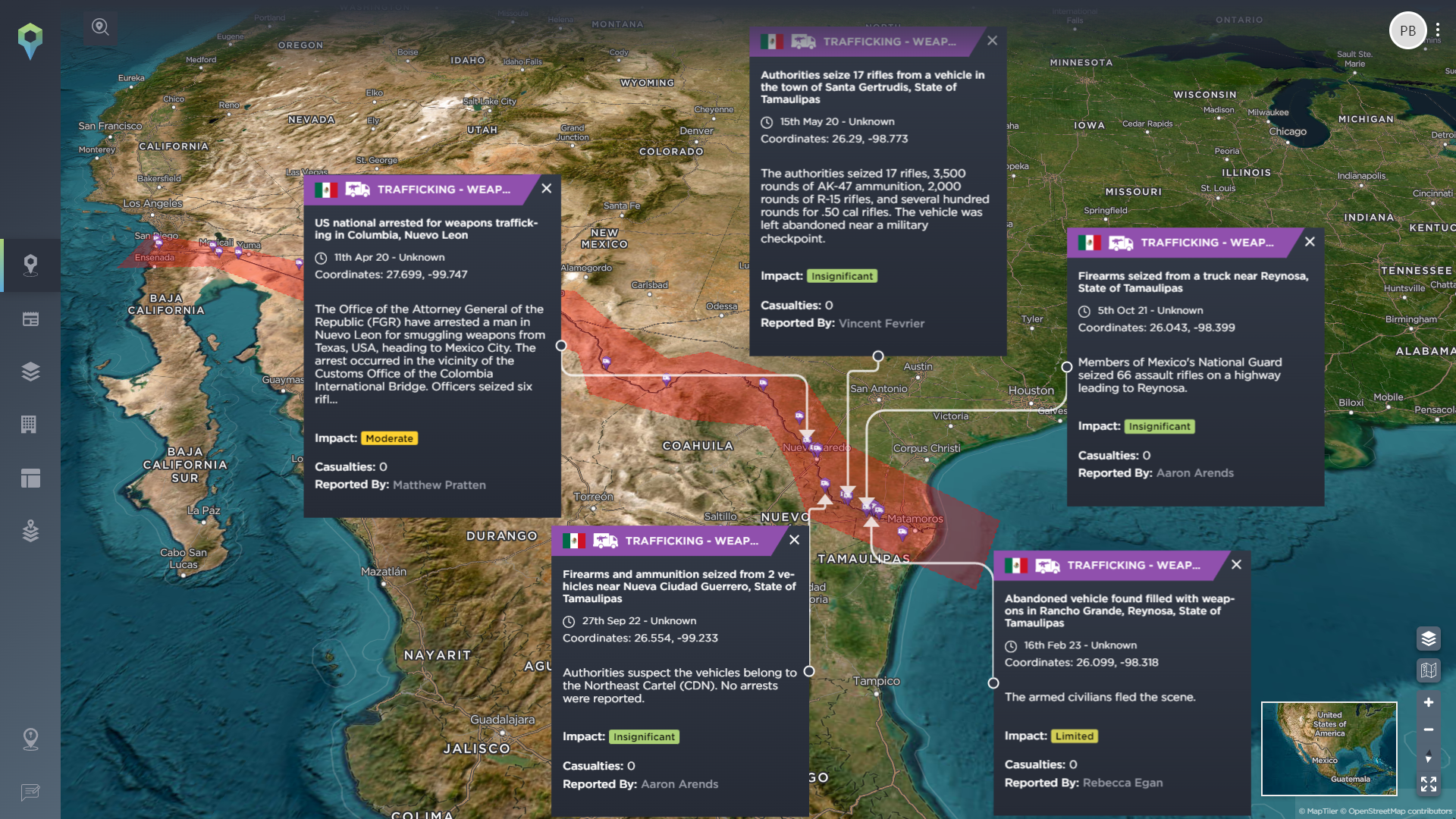The fourth wave fentanyl crisis in the U.S.
Examining the fourth wave of the ongoing U.S. fentanyl crisis, from the network of actors involved to the measures being taken to combat it.
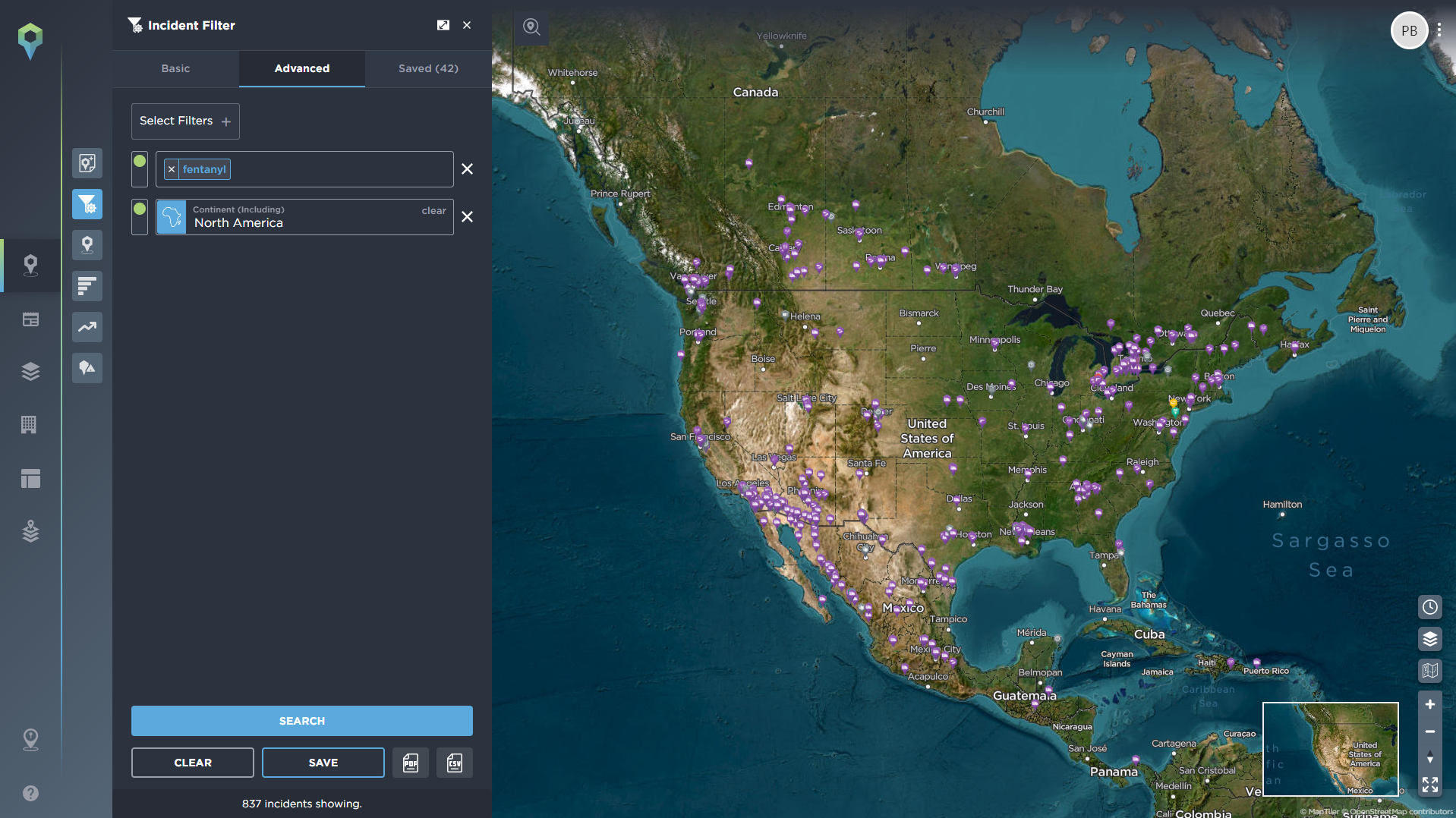
Fentanyl-related incidents in North America [image source: Intelligence Fusion]
The fentanyl crisis is a severe and complex challenge that significantly impacts numerous communities across the United States. Fentanyl, a synthetic opioid much more potent than heroin, has caused a dramatic increase in overdose deaths. Understanding the network of actors involved and the vulnerabilities within the system is crucial for developing effective countermeasures.
As healthcare reform remains the top priority for Biden’s voters, news outlets are filled with reports of drug overdoses and deaths. Emerging threats like pink fentanyl are coming to the surface. Pink fentanyl, like other fentanyl analogs, is significantly more potent than heroin and morphine. This heightened potency increases the risk of overdose, as even a small amount can be lethal. The margin for error in dosing is extremely narrow, making accidental overdoses more likely, especially among users who are unaware they are consuming fentanyl or are using it mixed with other substances. In light of the drug’s growing popularity, in March 2024, Attorney Jesse Laslovich, representing the District of Montana, and Billings Police Chief Rich St. John issued a public alert regarding the presence and rise of pink fentanyl in the community. The advent of pink fentanyl poses a fresh and significant hurdle for law enforcement agencies, and the blending of pink fentanyl with other illicit substances has generated a critical public health issue, with its heightened potency leading to fatal consequences.
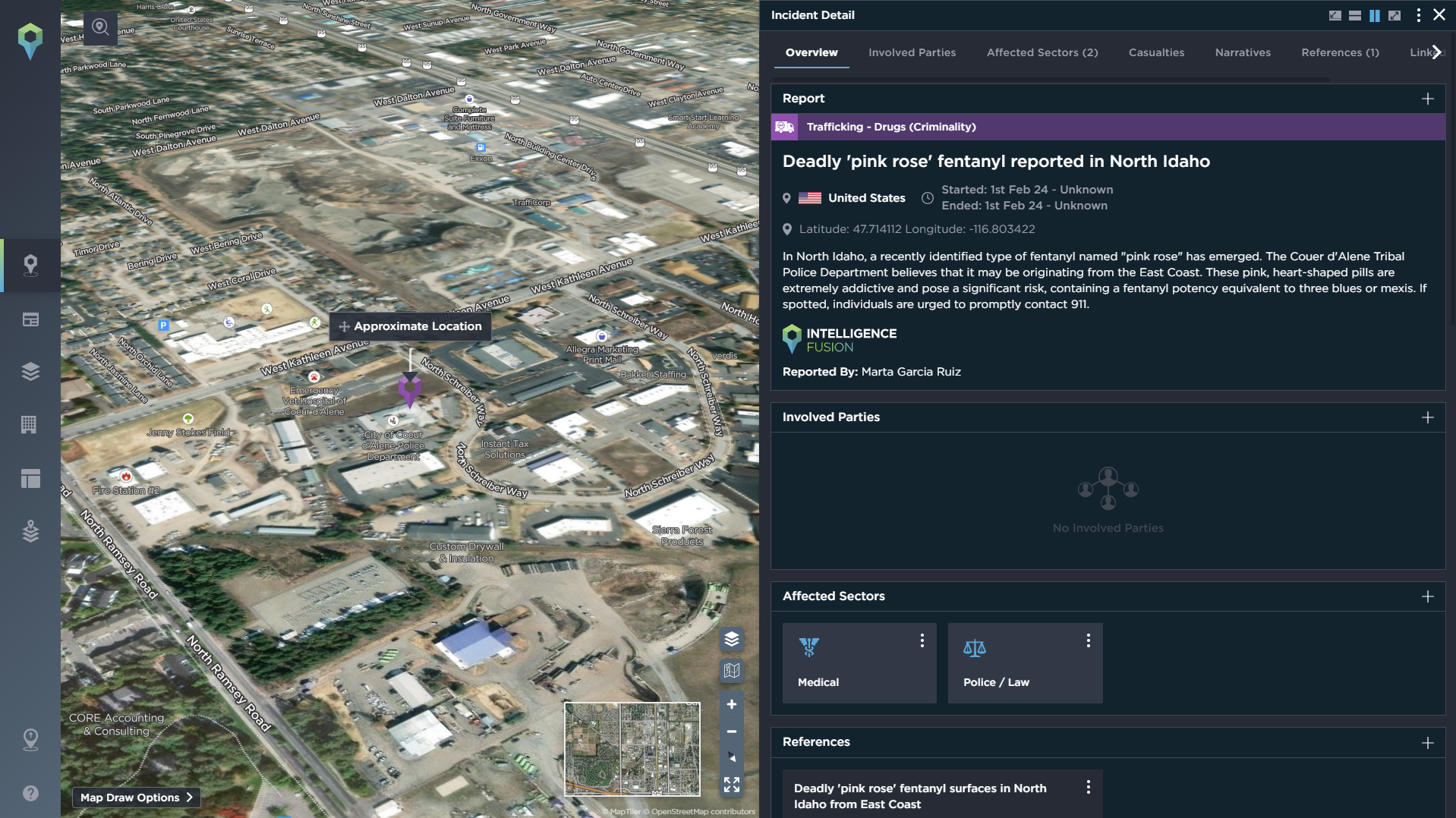
The advent of pink fentanyl poses a fresh and significant hurdle for law enforcement agencies [image source: Intelligence Fusion]
Key actors in the fentanyl crisis
Mexican cartels, particularly the Sinaloa Cartel and the Jalisco New Generation Cartel, are major players in the production and distribution of fentanyl. These organizations employ sophisticated smuggling methods, including building elaborate tunnels, using drones, and hiding drugs in legitimate cargo. They exploit vulnerabilities at legal border crossings and often coerce migrants into transporting drugs, which adds another layer of complexity to enforcement efforts.
Chinese chemical suppliers are crucial in this network, providing the precursor chemicals needed for fentanyl production. Whereas fentanyl was procured in the past directly from chemical producers, the class-wide scheduling of most fentanyl-related substances means that today, criminals use precursor chemicals to manufacture drugs such as fentanyl. These chemicals are often shipped to Mexico, where cartels process them into fentanyl. The suppliers often operate with minimal regulation, which makes it challenging to control the flow of these chemicals.
In the United States, intermediaries distribute and sell fentanyl, often using the internet and social media platforms to reach a broad audience. This method allows them to conduct transactions anonymously and promotes the sale of counterfeit pills that frequently contain fentanyl, leading to accidental overdoses among unsuspecting users.
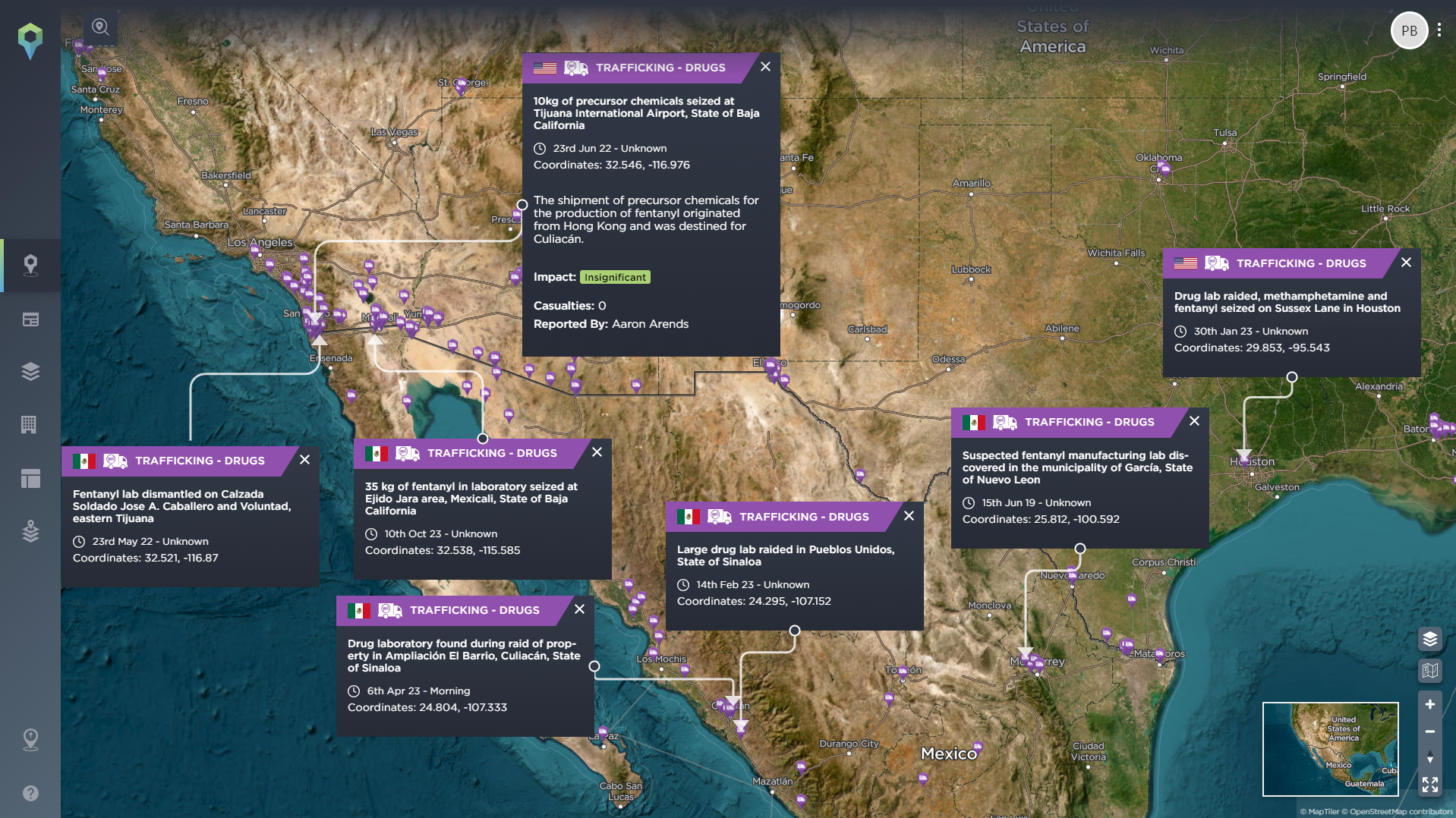
Incidents related to fentanyl manufacturing [image source: Intelligence Fusion]
Fentanyl trafficking routes and methods
The trafficking routes for fentanyl begin in China, where precursor chemicals are shipped to Mexico. Mexican cartels then process these chemicals into fentanyl and traffic the finished product into the United States. Smuggling methods include hiding fentanyl in legitimate cargo, using underground tunnels, deploying drones, and coercing migrants to act as couriers. These sophisticated tactics make it difficult for law enforcement to intercept all shipments. According to the DEA, the Sinaloa cartel is the primary supplier of cocaine to the U.S., particularly on the East Coast. Additionally, the organization is heavily involved in the trafficking of marijuana and heroin. It uses its billions of dollars in profits to expand its operations globally, establishing distribution hubs in cities such as Los Angeles, Seattle, Chicago, Atlanta, and Charlotte, North Carolina.
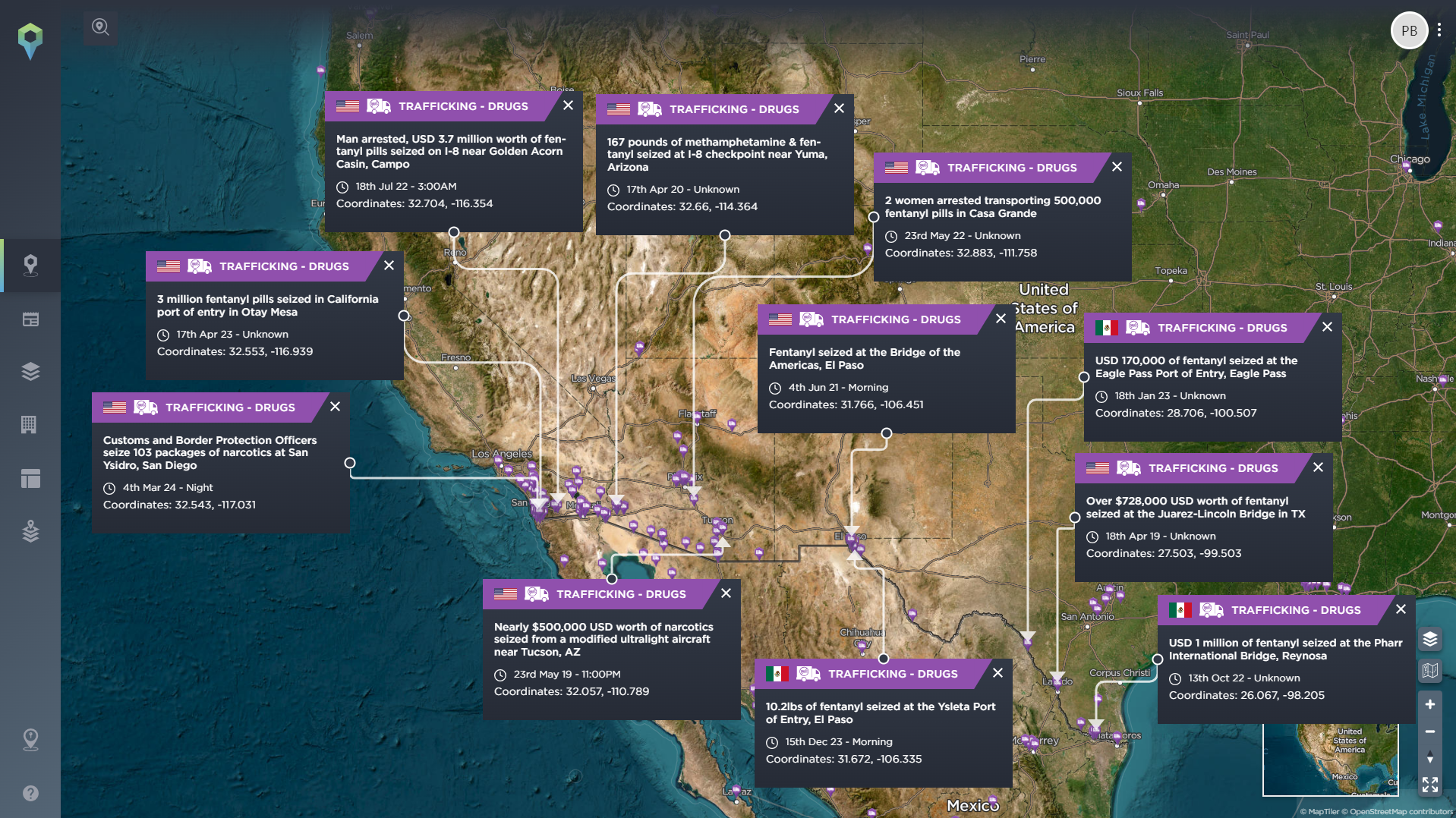
Fentanyl seizures reported on the U.S.-Mexico border [image source: Intelligence Fusion]
In the first five months of fiscal year 2024, U.S. Customs and Border Protection (CBP) and Homeland Security Investigations (HSI) seized over 13,000 pounds of fentanyl and made over 2,000 arrests related to fentanyl trafficking. Additionally, more than 1,500 pill presses were confiscated, which are critical in disrupting the production of illicit fentanyl. These seizures have significantly disrupted supply chains, although the vast quantity of fentanyl still reaching the U.S. indicates that traffickers continue to find ways to circumvent these efforts.
The administration has enhanced surveillance and interdiction capabilities at the border through high-tech drug detection machines. Operations like Apollo and Blue Lotus specifically target drug and chemical supply chains, gathering intelligence on smuggling routes and deploying resources to critical entry points. These operations have resulted in substantial drug interdictions, highlighting their effectiveness.
International collaboration, especially with China, has intensified to curb the supply of fentanyl precursor chemicals. The recent agreement between President Biden and Chinese President Xi Jinping aims to reduce the flow of these precursors, a significant step given China’s role as a major source of these chemicals. The Global Coalition to Address Synthetic Drug Threats, comprising over 140 countries, underscores the administration’s commitment to a coordinated global response.
Measures to combat the U.S. fentanyl crisis
The administration has allocated unprecedented levels of funding to combat the opioid crisis, with the FY 2024 budget requesting $46.1 billion for National Drug Control Program agencies. This funding supports disrupting drug trafficking operations and expanding access to addiction care. The State Opioid Response (SOR) grant program continues to provide substantial financial support for local treatment and recovery services.
Improving access to naloxone, an opioid overdose reversal drug, is a key public health measure. The FDA’s approval of over-the-counter naloxone aims to make this life-saving medication widely available. Guidelines to facilitate the distribution of naloxone by harm reduction programs have contributed to a stabilization or decrease in overdose deaths in some areas.
While the Biden administration’s efforts have led to notable achievements in seizing large quantities of fentanyl and disrupting supply chains, the persistence of high overdose rates indicates that the crisis is far from over. In summary, Biden’s initiatives have made significant strides; however, the challenge lies in maintaining and expanding these efforts to sustain progress and address the evolving tactics of drug traffickers. For instance, while seizures and arrests are significant, the impact on overall overdose death rates and the continued high availability of fentanyl in communities indicate ongoing challenges.
The business impact of the fentanyl crisis
While primarily a public health risk issue, the ways in which the fentanyl crisis overlaps with ongoing business risk issues, whether retail crime, the hijacking of supply chains, reputational risk, or geopolitical issues such as U.S.-China relations, mean it is worth monitoring from a private sector perspective, too.
The fentanyl crisis has also led to significant backlash against big pharmaceutical companies, partly due to their role in the opioid epidemic. Lobbying efforts by these companies have historically influenced opioid policies, often delaying steps intended to combat abuse while pushing their own priorities with lawmakers and regulators. Pharmaceutical companies and their allies have spent hundreds of millions on lobbying and political contributions, outspending advocacy groups by a wide margin, something that protesters are keen to point out. While the fentanyl crisis is in its 20th year, and the companies involved in original production have since been fined or settled into the billions of dollars, as the fourth wave of the crisis continues to become more severe, and gain public and government attention, the risk of protest and demonstration against the industry will also grow.
Social media platforms have come under scrutiny for facilitating drug sales. Advocates and attorneys have called on Congress to amend Section 230, which provides immunity for website platforms regarding third-party content, to hold social media companies accountable for illicit activities conducted on their sites. Campaigns such as Snapchat’s “Real Deal on Fentanyl” aim to educate young people about the dangers of fentanyl, but critics argue that more stringent measures and accountability are needed. In February 2024, a California state judge ruled that Snap must face a lawsuit from families whose children used the app to purchase fentanyl on the platform.
The secondary and tertiary effects of the fentanyl crisis can also directly impact business operations. The hijacking of legitimate supply chains by organised crime for the trafficking of goods is a well documented issue, and can cause costly disruption to an operation when goods are interdicted by customs. Workers are also at risk of exploitation by organised crime gangs, who use bribery, coercion, and threats to target employees within the supply chain to provide assistance with cross-border trafficking.
Additionally, opioid addiction has been documented to correlate with higher rates of offending; in the US, a 2017 DoJ report found that more than half (58%) of state prisoners and two-thirds (63%) of sentenced jail inmates met the criteria for drug dependence or abuse. While further research would be needed to establish a direct link between the two, major cities with high levels of fentanyl use, such as San Francisco, also score highly for retail crime.
At Intelligence Fusion, our threat intelligence data is relied on by the security and risk teams of large organisations across both the private and public sector.
Presented in an intuitive, easy to use platform, with incredibly granular filtering capabilities, analysts working in our 24/7 operations centre identify, track and map incidents across the globe that can impact the safety, security and integrity or your operations, assets and people.
As part of the Sigma7 umbrella, we work closely with specialists across the risk space, from risk management, consultancy and advisory, risk engineering and site security, and advanced security and risk eLearning and training services, to business intelligence, due diligence, and forensic accounting.
To learn more about what we do, and how we can work with your organisation to improve your risk and security exposure, reach out to a member of the team today.

